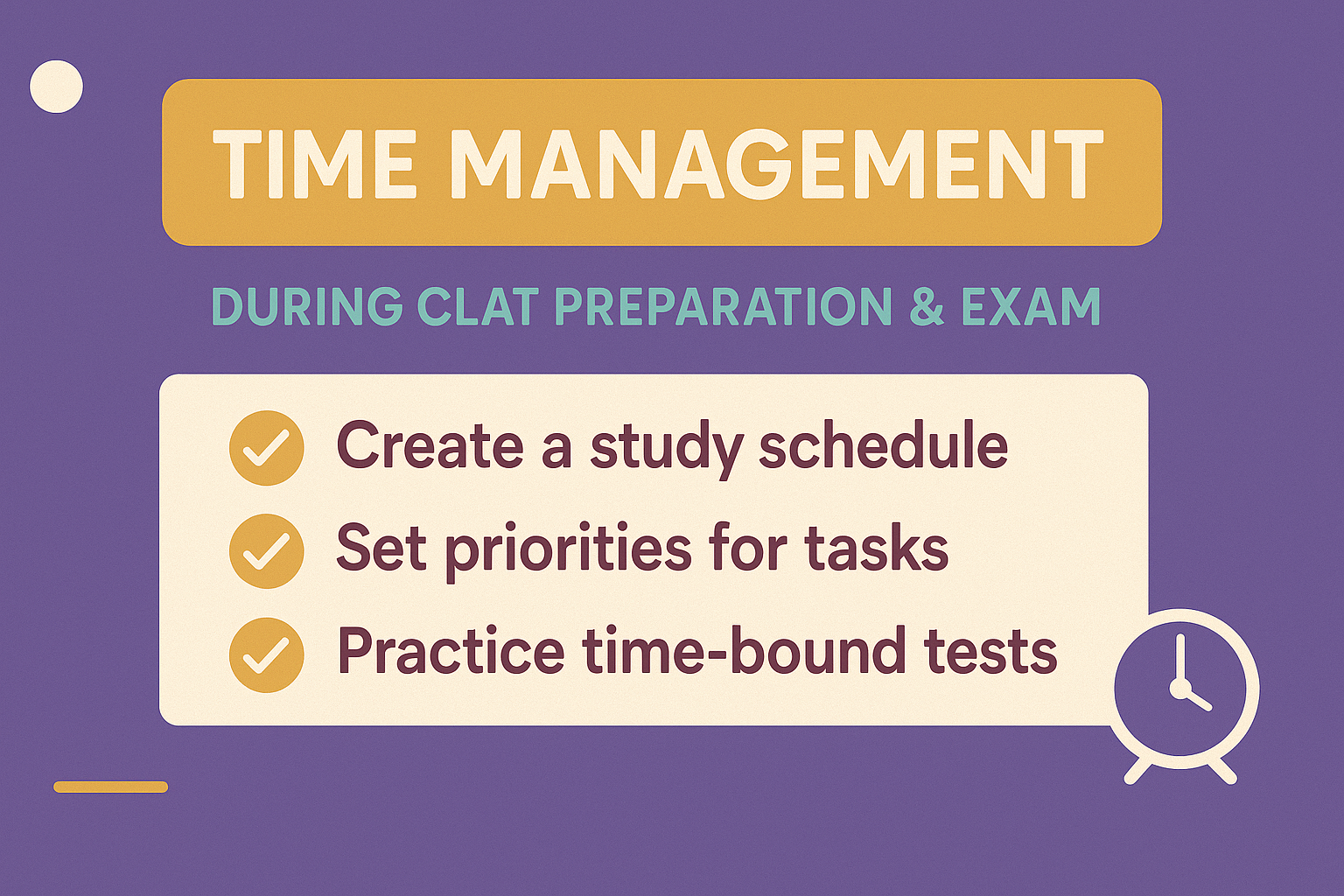Introduction
Time is the most crucial resource for every CLAT aspirant. With vast syllabus coverage, mock tests, current affairs, and revision—preparing for CLAT requires smart time management. Not just during preparation but also on the exam day, how you manage your time can significantly impact your final score.
In this comprehensive guide, we’ll discuss effective time management strategies for both CLAT preparation and the actual exam. Whether you’re in Class 11, Class 12, or taking a drop year, these tips will help you study smarter, stay focused, and perform better on the big day.
Why Time Management Matters in CLAT
CLAT is time-bound with 120 questions in 120 minutes—that’s 1 minute per question.
Questions are comprehension-based and lengthy, especially in English, Legal Reasoning, and Logical Reasoning.
Poor time allocation during the test can lead to panic, skipped questions, or careless errors.
Strategic planning before and during the exam ensures maximum accuracy in minimum time.
Time Management Tips During CLAT Preparation
1. Create a Realistic Study Schedule
Divide your day into focused study slots (e.g., 3-4 blocks of 2 hours each).
Allocate time for each section: Legal, Logical, English, GK/Current Affairs, Quantitative Techniques.
Set weekly and monthly goals (e.g., finish legal reasoning basics by Week 2).
Include breaks, revision, and mock tests in your schedule.
2. Prioritize Your Weak Areas
Use diagnostic tests to find your weak sections.
Spend extra time on areas where your accuracy is low.
Don’t neglect strong areas but balance preparation wisely.
3. Use the Pomodoro Technique
Study for 25 minutes, then take a 5-minute break.
After four cycles, take a longer break of 15–30 minutes.
This boosts focus, avoids burnout, and helps in retaining more in less time.
4. Practice Mock Tests with Timers
Simulate actual exam conditions.
Practice solving 120 questions in exactly 120 minutes.
Analyze time spent on each section after the test.
5. Set Daily Targets, Not Just Timetables
Instead of rigid hourly plans, aim to complete specific tasks, like:
Solve 3 RC passages
Read daily editorials
Revise 50 current affairs MCQs
6. Avoid Multitasking
Focus on one section at a time.
Avoid switching between subjects quickly—it leads to mental fatigue.
7. Reduce Time-Wasters
Track where your time goes: social media, excessive breaks, distractions.
Use productivity apps like Forest, Notion, or Google Calendar to stay organized.
Time Management Tips During the CLAT Exam
1. Allocate Time Per Section Smartly
Here’s a suggested time allocation:
English Language: 20 minutes
Current Affairs including GK: 10–12 minutes
Legal Reasoning: 35–40 minutes
Logical Reasoning: 25–30 minutes
Quantitative Techniques: 10–12 minutes
Tip: Start with your strongest section to build confidence early in the exam.
2. Use the 3-Pass Strategy
First Pass: Answer easy questions quickly.
Second Pass: Revisit slightly tougher ones.
Third Pass: Attempt the most time-consuming questions if time permits.
3. Don’t Get Stuck on a Single Passage
If a passage or question seems tough, move on and return later.
Mark it for review and save time for higher accuracy.
4. Use the Rough Sheet Effectively
Don’t overuse the rough sheet for questions that are verbal-based.
Use it primarily for Quant and Logical puzzles only.
5. Keep 5 Minutes for Review
Try to end the test 5 minutes early and go through marked questions.
Correct any mistakes and ensure all answers are attempted.
Time Management Tools to Use
Google Calendar or Notion: For daily scheduling
Forest App: For focused study sessions
Timer or Stopwatch: For practice sessions and mock tests
Weekly Review Charts: To track progress and improve time allocation
Common Time Management Mistakes to Avoid
Over-scheduling or under-scheduling your day
Ignoring revision and focusing only on new topics
Spending too much time on difficult topics or current affairs
Taking mock tests without analyzing results
Not simulating exam conditions during practice
FAQs on Time Management for CLAT
Q1. How many hours should I study daily for CLAT?
A: Ideally, 5–6 focused hours per day is enough if you follow a proper plan and study smartly.
Q2. Can I prepare for CLAT in 3 months with time management?
A: Yes, with strict time management, dedication, and regular mock tests, 3 months is sufficient to crack CLAT.
Q3. How do I manage time between school and CLAT prep?
A: Use early mornings, evenings, and weekends effectively. Prioritize quality over quantity during school days.
Q4. Should I start mock tests early?
A: Yes. Start mocks early in your preparation to understand your strengths and adjust your schedule accordingly.
Q5. What’s the best way to manage time during the CLAT exam?
A: Divide the 120 minutes section-wise and don’t spend too much time on any single passage or question. Always save time for review.
Conclusion
Time management can be your biggest ally or your worst enemy during CLAT preparation and the exam itself. With a clear study plan, disciplined practice, and section-wise time allocation strategies, you can maximize efficiency, reduce stress, and significantly improve your final performance.
Start managing your time today—because how you use your hours will determine your rank on CLAT day.










